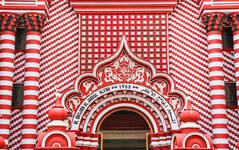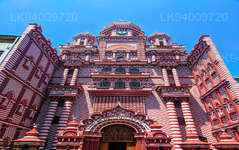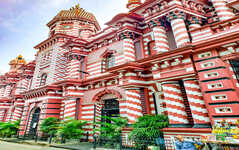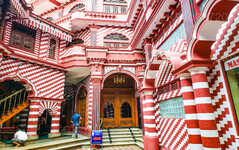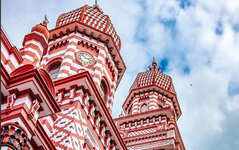
Коломбо-Сити
Коломбо, столица Шри-Ланки, — динамичный город, сочетающий традиции и современность. Здесь можно увидеть колониальную архитектуру, оживленные рынки и умиротворяющие буддийские храмы. Благодаря разнообразной кухне, растущему горизонту и прекрасным пляжам, Коломбо — оживленный деловой, культурный и туристический центр, предлагающий возможность исследовать чудеса Шри-Ланки.
Red Mosque
The Jami Ul-Alfar Mosque, also known as the Red Mosque (not to be confused with the Red Mosque of New Delhi), is one of Colombo’s oldest mosques. The Arabs arrived for the first time in Sri Lanka for trade in the 7th century AD. As olden days Ceylon was a hub for trade and was right in the middle of the spice and silk routes; they maintained a constant presence in Sri Lanka since that time by either migrating or intermarrying with the locals. Most Islamic communities settled in Colombo or Galle where the main ports were located; and to this day their descendants continue their lives in these areas. And hence as a result Colombo, with its being a major trade zone of the country, has a very big population of Muslims. But there was a severe lack of large mosques, which made life very difficult for the local Islamic community as their religion enforced praying 5 times a day.
The Jami Ul-Alfar Mosque was built in 1908 in Pettah to cater to the growing need for a large place for religious repose. The design and construction were done by Habibu Labbe Saibu Labbe an unknown architect of the time. He used Indo-Saracenic structural images, given to him by the South Indian traders who commissioned him, as his base; but also mixed in elements of his own. One of the most notable architectural changes is that the dome-shaped spires on top of the mosque are not of the typical onion shape. Instead, its shape follows that of a pomegranate; while its walls are painted the same shade of red as the innards of that fruit, along with pale yellow horizontal stripes. This red tone is why the mosque gained its nickname. The mosque had approximately two floors (unsure of the exact amount as renovations were done later, and the locals in the know-how refuse to speak much about its history) at the time; which were supported by four massive teak tree columns that pass through the two lower floors.The construction was completed in 1909 and the mosque could hold a capacity of 1500 people; though only about 500 attended regularly there at that time. However, the numbers grew swiftly and in 1975 the Haji Omar Trust took control of the surrounding properties and began the work of expanding the mosque.
In 2007, there was a new four-storied wing built, allowing the mosque to increase its capacity to 10,000. Today the mosque continues to update and refurbish its facilities.
Visitors are greeted by beautiful minarets and spires straight from a Persian fairytale, which is seen for miles all around. The bright red and pale yellow stripes of its walls make the mosque stand out in the crowded street with all its shops and buildings of trade and business. The tiles of the inner part of the mosque have been replaced with those that have an early 20th century Period design; which gives the entire area a beautifully aged aura. The four teak support columns are still there in pristine condition. The mosque doesn’t skimp on modern-day facilities though; and was most recently having an escalator facility built for elderly and infirm visitors.
However, there seems to be a ban on Muslim women to visit the mosque due to religious restrictions. As there have been many who requested a section for the women; there appears to plan for such a section, where women can do their prayers, to be built in the future.
Though the Red Mosque is an Islamic religious facility, visitors from other religions are eagerly welcomed.
О округе Коломбо
Коломбо — крупнейший город и коммерческая столица Шри-Ланки. Он расположен на западном побережье острова, рядом со Шри-Джаяварденепура-Котте, столицей Шри-Ланки. Коломбо — оживлённый и динамичный город, сочетающий в себе современную жизнь, колониальные здания и руины. Население города составляет 647 100 человек. Столичный регион Коломбо, включающий округа Коломбо, Гампаха и Калутара, насчитывает около 5 648 000 человек и занимает площадь 3 694,20 км². Коломбо — многоэтнический и многокультурный город. Это самый густонаселённый город Шри-Ланки: в черте города проживает 642 163 человека. Население Коломбо представляет собой смесь многочисленных этнических групп, в основном сингалов, мавров и тамилов. В городе также проживают небольшие общины выходцев из Китая, Португалии, Голландии, Малайзии и Индии, а также многочисленные европейские экспатрианты. Подавляющее большинство шри-ланкийских корпораций имеют свои головные офисы в Коломбо. Среди отраслей промышленности – химическая, текстильная, стекольная, цементная, кожевенная, мебельная и ювелирная. В центре города находится второе по высоте здание в Южной Азии – Всемирный торговый центр.
О Западной провинции
Западная провинция — самая густонаселённая провинция Шри-Ланки. Здесь расположена столица Шри-Джаяварденепура-Котте, а также Коломбо, административный и деловой центр страны. Западная провинция разделена на три основных округа: Коломбо (642 км²), Гампаха (1386,6 км²) и Калутара (1606 км²). Будучи экономическим центром Шри-Ланки, город представлен всеми крупными местными и международными корпорациями, а также ведущими дизайнерскими магазинами и магазинами масс-маркета. Приготовьтесь к шопинг-терапии в Западной провинции. Здесь, где проживает самое большое население среди всех провинций, расположены практически все ведущие учебные заведения острова. Университеты провинции включают Университет Коломбо, Университет Шри-Джаяварденепуры, Университет Келании, Открытый университет Шри-Ланки, Буддийский и палийский университет Шри-Ланки, Университет обороны имени генерала сэра Джона Котелавалы и Университет Моратувы. В Западной провинции находится самое большое количество школ в стране, включая национальные, провинциальные, частные и международные школы

